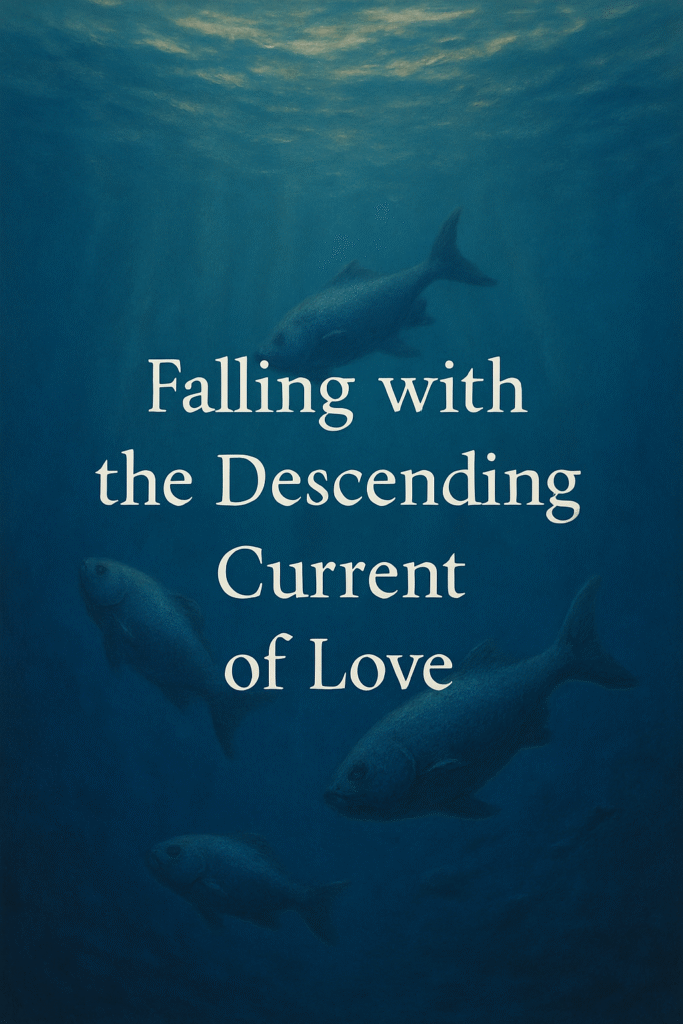LOVE THAT GROUNDS: INTRODUCING THE DESCENDING CURRENT
Some forms of love do not lift us upward but bring us inward and downward—into the body, into memory, into the palpable here-and-now. They deepen us. They help us settle into presence. They ask us not to rise above life but to be fully in it. This is the Descending Current of Love: the movement of spirit not toward escape or transcendence, but toward intimacy, incarnation, and wholeness. It doesn’t long for what could be—it turns with reverence toward what is.
We’ve all felt it—those moments when love touches us not like fire from above, but like roots wrapping gently around the heart. When a friend holds us in grief, when a lover’s embrace feels like a homecoming, when we see ourselves reflected in another’s gaze and remember who we are—these are all expressions of the descending current. Here, the soul’s motion is not to fly, but to dwell. Not to escape, but to inhabit.

HOMOPHILIA, MIRRORING, AND THE PATH OF PRESENCE
Where eros climbs in search of the divine, agape and philía—forms of love rooted in presence and recognition—tend to flow downward, infusing the world with meaning and depth. The descending current is about embodiment, not elevation. It honors the sacred in flesh, in emotion, in ordinariness. It teaches us to say yes to what is, without flinching.
And if heterophilia, the love of difference, aligns with the ascending arc, then homophilia—the love of sameness, of resonance, of deep kinship—finds its home in the descending current. Homophilia isn’t merely same-sex attraction; it’s the deeper pattern of loving what reflects, affirms, and reveals the self from within. In its purest form, it is the soul recognizing itself in another—not as projection, but as participation.
This is the energy behind much of gay love, especially when it’s not oriented toward escape or transcendence. It’s the love of familiarity, of spiritual resonance, of a shared language of being. And in this love, there’s often a desire not to rise above life but to sink more deeply into it—to be more real, more alive, more connected.
THE WISDOM OF HEALTHY DESCENT
When the descending current is flowing freely, it brings us into sacred contact with the present moment. It teaches us to inhabit our bodies with awareness, to feel our feelings without judgment, to embrace the beauty and complexity of others without trying to fix or change them. It’s a path of healing—not by transcending suffering, but by being with it. Not by transforming others, but by witnessing them fully.
This is the current that underlies truly grounded love: the love that says “I see you” not from a pedestal but from eye level. It’s the love that shows up in caregiving, in friendship, in emotional attunement, in holding space. It’s the kind of love that doesn’t need to reach the heavens because it finds the holy in the mud.
When the descending current is alive in us, we speak differently. We say things like, “I felt completely at home in his presence,” or “She made me feel seen for who I am.” We describe love not as flight, but as settling, softening, resting. These metaphors matter, because they orient us toward integration rather than transcendence.
THE SHADOW OF FALSE DESCENT
But like the ascending current, the descending current can become distorted. When we collapse too far into the body without awareness, or when we use emotional intensity to avoid spiritual spaciousness, we risk sinking into a form of love that is fused, enmeshed, or addictive. What began as presence becomes stickiness. What began as embodiment becomes entrapment.
This is what I call false immanence—when we confuse attachment for intimacy, or intensity for authenticity. It can look like emotional codependence, where the boundaries between self and other dissolve not in union, but in confusion. It can show up as obsessive relationships, compulsive caregiving, or staying in harmful situations out of misplaced loyalty.
False descent is not grounded; it’s stuck. It doesn’t bring us into presence—it drowns us in reactivity. And it often wears a mask of devotion. In queer love, this can sometimes appear as a longing for sameness that becomes self-erasure—a desire to lose oneself in another because that feels safer than standing alone.
The danger of corrupted descent is not just emotional. It’s spiritual. When we romanticize suffering, when we conflate collapse with depth, we forget that love’s true descent is into truth, not just into feeling. And we lose the capacity to return to center.

SPEAKING THE DEPTHS WITH CLARITY
Just as we are called to discern our ascents, we must also learn to navigate our descents. Is our movement downward one of deepening—or of drowning? Are we becoming more fully ourselves, or losing ourselves in the name of love? These are not easy questions. But they are necessary ones.
Our language is one of our most powerful tools. When we speak of descent, let us speak not only of falling, but of rooting. Let us use metaphors that connect us to truth, not just to intensity. Let us remember that the Descending Current of Love is not passive—it is conscious, chosen, and sacred.
And as for homophilia—the love of sameness, resonance, mirroring—it remains one of the most profound expressions of this current. When we look into the eyes of another and see ourselves reflected not with distortion, but with compassion, we are not escaping into fantasy. We are coming home. Homophilic love, when lived wisely, is a path of self-revelation. It teaches us to love what is near, familiar, even wounded—and to find the divine not in climbing toward heaven, but in touching the earth together.




